Contemporary Bathroom Designs: Trends and Tips

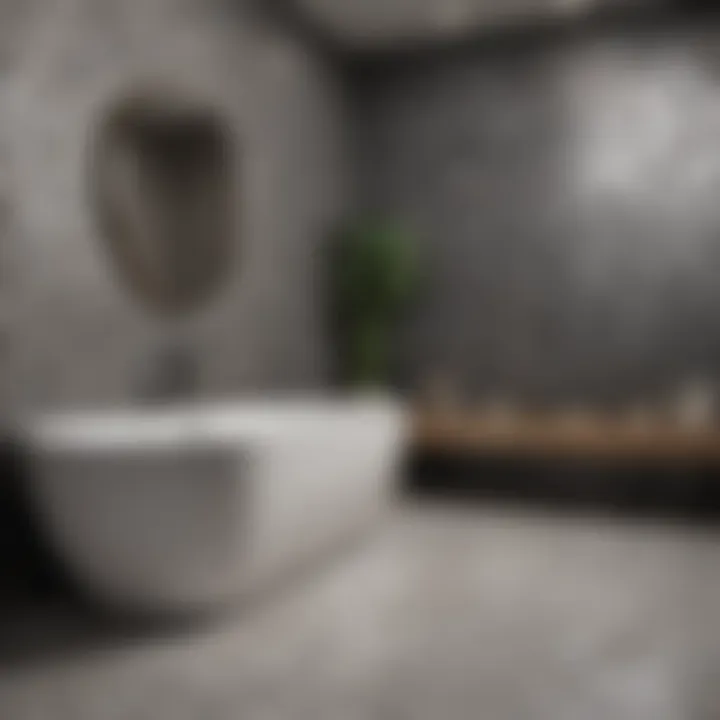
Intro
Bathrooms today have transformed into more than just functional spaces; they are sanctuaries where one can unwind and recharge. This evolution mirrors broader trends in home design and lifestyle choices. As homeowners seek to craft personal retreats, the emphasis on aesthetics, comfort, and practical functionality has surged. This article aims to peel back the layers of contemporary bathroom design by presenting insights into current trends, design inspirations, and practical tips that could not only enhance the look but the experience of your bathing space.
Through a detailed exploration, we intend to provide you with a comprehensive perspective—drawing from the latest styles and their practical implications. Whether you're starting fresh with a remodel or looking to infuse modern touches into an existing space, understanding these elements is key.
Let’s kick off this journey towards creating the bathroom of your dreams.
Defining Contemporary Bathrooms
Understanding what a contemporary bathroom is all about sets the stage for transforming a simple washroom into a relaxing retreat. These spaces go beyond mere function; they combine functionality with aesthetics, creating environments that respond to modern living. In this exploration, we delve into how the essence of contemporary design reshapes our experiences in these often overlooked areas of our homes.
Historical context of bathroom design
The journey of bathroom design is a fascinating one. If we look back, the concept of a bathroom as we know it today didn’t really take shape until the late 19th and early 20th centuries when sanitation became a priority in urban living. Before that, the facilities were basic and often located outside the main living area. The advent of indoor plumbing was a game changer, leading to more elaborate designs and fixtures.
Moving through the decades, the bathroom evolved significantly during the post-war era, where mass production of materials enabled a variety of styles to flourish. From the bold colors and patterns of the 1960s to the minimalistic approach in the late 20th century, each era left its mark. Today, modern bathrooms reflect a blend of influences, marrying functionality with sleek designs and smart technology, making them key elements of our homes.
Characteristics of contemporary aesthetics
Contemporary bathrooms aren't just about looking good; they portray a lifestyle. Here’s what stands out:
- Simplicity: The guiding principle in contemporary design is simplicity. Clean lines, uncluttered spaces, and minimal ornamentation dominate.
- Natural Light: Large windows and skylights that bring in ample natural light are essential. This approach not only makes the space feel larger but also creates a calming, inviting atmosphere.
- Neutral Palette: Colors are often kept neutral—think whites, grays, and earthy tones. This color scheme provides a serene backdrop that pairs well with bold accents or artwork.
- Eco-Friendly Choices: There’s a growing emphasis on sustainability. Using recycled materials, low-flow fixtures, and energy-efficient lighting are common practices.
- Texture and Layers: Contemporary design embraces a mix of textures. You might find smooth stones, rough wood, or sleek glass harmoniously combined in a single space.
A contemporary bathroom is more than a room. It’s a reflection of changing tastes and lifestyles, making it essential for homeowners and design enthusiasts alike to appreciate these defining elements.
Space Planning and Layout
Space planning and layout play a pivotal role in defining the success of contemporary bathrooms. This isn’t just about where the tub goes or how far apart the sink and toilet should be. Instead, it's a holistic approach that considers the width of the doorway, the rights of passage through the room, and how all the functional elements coexist in harmony. When one gets it right, the bathroom not only serves its fundamental purpose but also offers an oasis of comfort and calm amidst daily chaos.
Importance of spatial efficiency
Spatial efficiency refers to maximizing the use of available space while minimizing clutter. In contemporary bathroom design, this becomes essential due to often limited square footage.
- Optimal Layout: The layout should promote ease of movement—think of how many times you rush in there. Ensuring ample room to maneuver can avoid those awkward moments when two people are trying to share the same space.
- Underutilized Areas: Consideration of areas such as corners or above the commode can lead to innovative storage solutions. Perhaps a corner rack or a narrow cabinet can fit snugly in places that previously appeared useless.
- Balanced Proportions: Space efficiency also means maintaining visual balance. Crowding a tiny bathroom with oversized fixtures can lead to chaos, while smaller, well-proportioned elements can create a sense of openness.
Creating a functional flow
Functional flow is the sort of magic that happens when everything clicks seamlessly in the bathroom. Imagine waking up and having everything you need right where you expect it.
- Task-Oriented Zones: Breaking the bathroom into distinct zones—like a washing area, a grooming station, and a private space—is beneficial. This separation aids in decluttering and enhances usability.
- Sensible Navigation: The pathways between these zones should be clear and intuitive. A design that permits users to glide from one function to another without barriers makes the morning routine less of a sprint and more of a waltz.
- Heightened Accessibility: This becomes especially crucial as we think about families or guests who may not be familiar with the layout. Clear visual pathways can guide users naturally, helping prevent unnecessary confusion.
Zoning principles for bathrooms
When it comes to zoning in a bathroom, it’s not just about setting aside physical areas for different tasks; it’s about creating an aesthetic flow that marries practicality with design.
- Private vs. Shared Spaces: In larger bathrooms, you may want to create a private area with a tub or shower that provides a retreat, while also ensuring that shared spaces like sinks are easily accessible. Consider some glass partitions or half-walls to offer a sense of separation without complete isolation.
- Climate-Control Zones: Think about introducing climate elements, such as heated flooring or towel warmers in specific areas where you want comfort versus areas that serve utilitarian purposes—like the toilet.
- Visual Harmony: Balance the materials and colors used in each zone, creating a cohesive look while still allowing each section to stand out. For example, you can use lighter tones in the bathing area to create an airy feel, while integrating moodier hues around the vanity.
"Space is not an absence of substance, but a structure within which our lives are lived" - this philosophy can echo profoundly in bathroom design.
Incorporating effective space planning and layout is not just about function; it's about crafting a personal haven where the chaos of life can be washed away. A successful bathroom layout isn’t merely a convenience; it’s a thoughtful approach to living well.
Materials and Finishes
In contemporary bathroom design, the choice of materials and finishes plays a pivotal role in determining not just the aesthetic appeal but also the functionality and longevity of the space. This aspect forms the backbone of how a bathroom feels and functions, influencing everything from cleaning ease to safety. By thoughtfully selecting materials, homeowners can create environments that are not only visually stunning but also durable and practical.
Natural vs. synthetic materials


Here's the crux: natural materials, like stone and wood, bring warmth and a sense of connection to nature, while synthetic materials offer versatility and often require less upkeep. Natural stones, such as marble or granite, can imbue a space with elegance, presenting unique veining and textures that add character. However, they can be a bit of a handful, needing regular sealing and attention to avoid stains and damage.
On the flip side, synthetic alternatives, like quartz or vinyl, are rising stars in bathroom design. They can mimic the appearance of natural materials but offer higher resistance to moisture and stains. This can save time and fustration down the line. Homeowners should weigh the aesthetic desires against maintenance expectations, along with how these materials align with their overall design vision. In the end, it’s all about balance.
Textural contrasts in design
Textural elements can dramatically enhance the visual interest within a bathroom. Mixing smooth finishes, like glossy tiles, with rough textures, such as rustic stone, can create a dynamic environment that's comforting and stimulating. For instance, a sleek shower with glass panels paired against a rough-hewn wooden vanity can draw the eye and create a layered look.
These contrasts are not just for show; they can also improve functionality. A textured floor surface can reduce slipping hazards, while glossy surfaces are typically easier to wipe clean. Being conscious of these combinations helps in not only achieving balance visually but also practically.
Furthermore, textural contrasts allow for personalization. Homeowners can infuse their character into the space by playing with various finishes and textures, making the bathroom a reflection of their unique style and sensibility.
Sustainable materials in contemporary bathrooms
The call for sustainability has never been louder, and the bathroom is no exception. Many homeowners now seek materials that not only look the part but are also kind to Mother Earth. Options like bamboo or recycled glass tiles are gaining traction. These materials are not just sustainable; they can bring a fresh and innovative look to the design, ensuring that aesthetics are not sacrificed for eco-friendliness.
In choosing sustainable materials, it's vital to consider the entire lifecycle of the product—from sourcing to disposal. A sustainable bathroom is not just about the materials used; it’s also about creating a long-lasting space that minimizes waste. By investing in quality finishes, the need for frequent replacements diminishes, reducing both environmental impact and costs over time.
Moreover, integrating sustainable practices in material selection can appeal to environmentally conscious buyers if the home is ever put on the market, making it a win-win.
"Materials and finishes are not merely components; they are the very essence of a bathroom's soul."
Color Schemes and Lighting
In the realm of contemporary bathroom design, color schemes and lighting play a pivotal role in creating not only the aesthetic appeal but also the overall atmosphere of the space. The right colors can evoke feelings of calmness, energy, or even luxury, while effective lighting enhances functionality and mood. Understanding how to balance these elements is essential for homeowners and design enthusiasts looking to transform their bathrooms into personalized retreats.
Psychology of color in design
Colors affect our mood and perception; this is especially true in a bathroom, where many begin and end their day. For instance, shades of blue and green often conjure a sense of tranquility and freshness, resembling nature and water. On the other hand, warm tones such as yellows and oranges can inject energy into a space but might feel overwhelming if overused.
When selecting palettes, consider these aspects:
- Neutrals: Colors like beige, gray, or soft whites provide a versatile backdrop that allows for easy changes in decor without a dramatic overhaul. They also reflect light well, enhancing brightness.
- Accent Colors: Adding pops of color through accessories such as towels, mats, or decor can refresh the design. Deep plum or forest green as accent colors can make striking choices against a neutral canvas.
- Monochromatic Schemes: Using various shades of a single color adds depth and creates a cohesive feel without breaking the tranquillity that bathrooms often embody.
Moreover, psychology suggests that how we feel in a space is largely influenced by the colors surrounding us. So, it’s wise to choose something that resonates with personal sense of style while also being mindful of its emotional impact.
Layering light sources for ambiance
Lighting can be the secret ingredient that transforms a bathroom from mundane to magnificent. Layering is key when it comes to creating a well-lit, welcoming environment. Here’s how you can achieve this:
- Ambient Lighting: This serves as the main source of illumination. Ceiling fixtures or recessed lighting can act as functional general lighting. Opting for dimmable fixtures allows you to adjust brightness according to time of day or mood.
- Task Lighting: Important for areas where activities take place, such as the vanity or shower. Sconces or LED strip lights around mirrors can provide the necessary brightness when applying makeup or grooming.
- Accent Lighting: This focuses on highlighting design features or creating a mood. Think warm light under a floating vanity, interesting textures illuminated by spotlights, or even candles for a touch of spa-like relaxation.
- Natural Light: Whenever possible, incorporating windows or skylights invites daylight into the bathroom, reducing the need for artificial light during the day. Adding sheer curtains offers privacy while still allowing light to filter through.
Innovative Fixtures and Fittings
Innovative fixtures and fittings are imperative to the realm of contemporary bathroom design. They're not just about aesthetics; they play a pivotal role in both functionality and the overall experience of the space. By embracing forward-thinking solutions, homeowners can elevate their bathrooms into retreats that efficiently meet their needs, transforming these spaces into serene havens that blend comfort with usability.
Smart technology integration
Today’s smart technologies are reshaping how we interact with our bathrooms. The integration of smart fixtures such as sensor-activated faucets, smart showers, and toilet systems that adjust to your preferences can provide immense convenience. For instance, automatic faucets help save water, while smart showers allow for pre-set temperature adjustments, making the morning routine a breeze. Moreover, the connectivity of these devices often allows for control through smartphones or voice-activated systems, further enhancing their utility.
Homeowners are increasingly drawn to the idea of creating personalized experiences; smart mirrors with built-in LED lighting and touch controls exemplify this. These mirrors can provide various lighting settings suitable for every mood or task, from bright task illumination to soft, relaxing light during a soak. The simplicity of installation combined with high-tech integration makes these fixtures a worthy investment for anyone looking to update their bathroom without a complete overhaul.
Unique plumbing fixtures: beyond the basics
Gone are the days when plumbing fixtures were merely functional. Today, the focus is on aesthetics as much as practicality. Unique plumbing fixtures have become conversation starters, adding a touch of personality and flair to bathrooms. From exquisitely designed sinks to eye-catching faucets, these aren't just items to use; they are expressions of style.
Consider the trend of wall-mounted faucets, which declutter countertops while adding a sleek look to the overall design. Alternatively, freestanding bathtubs can serve as striking focal points in a bathroom, bringing a spa-like vibe to the space. These fixtures not only serve a purpose but also problematically enhance the visual allure of contemporary bathrooms.
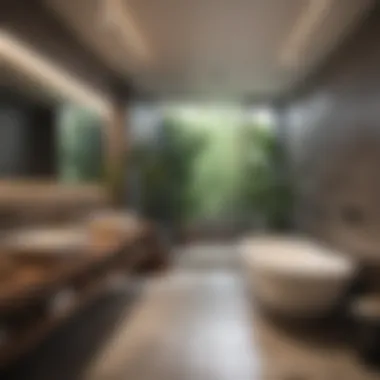
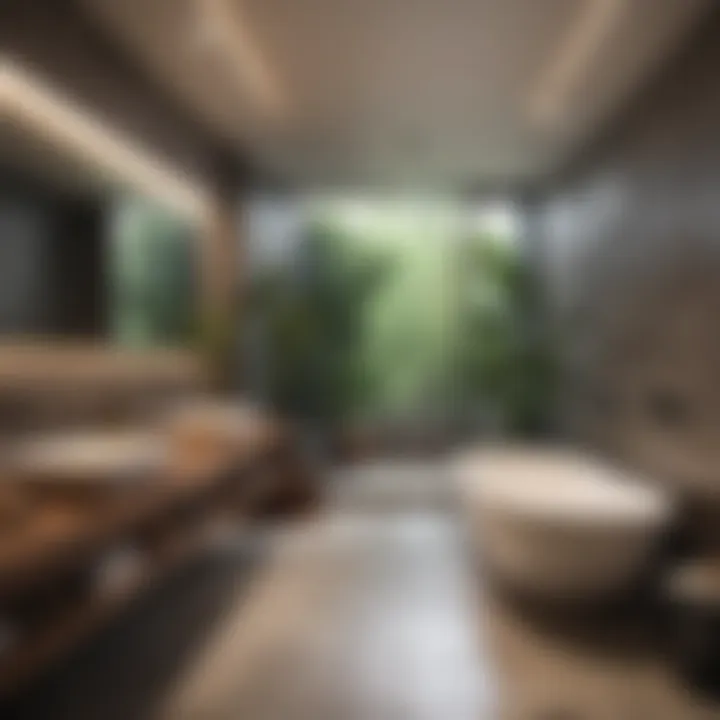
Innovative fixtures transform not just how we use bathrooms, but also how we feel in them. A well-placed faucet or a uniquely styled tub can change the atmosphere entirely.
Overall, innovative fixtures and fittings stand as a testament to the possibilities available in contemporary bathroom design. By incorporating smart technologies and unique plumbing options, homeowners can create spaces that reflect their individual tastes while maximizing efficiency. As these trends evolve, the line between function and style continues to blur, ensuring that bathrooms are no longer mere utility spaces but rather personal sanctuaries.
Storage Solutions
In today's contemporary bathroom design, the importance of smart storage solutions cannot be overstated. Gone are the days when bathrooms were merely functional spaces; they have transformed into personal retreats that require not only aesthetics but also efficient organization. The right storage solutions can greatly enhance the usability of a bathroom, allowing for a clutter-free environment that promotes serenity and relaxation. Without proper planning, even the most beautifully designed bathroom can appear chaotic and disorganized. Therefore, it's essential to consider innovative ways to integrate storage into the design.
"Thoughtful storage not only maximizes space but also elevates the overall experience in a bathroom."
Maximizing vertical space
One of the smartest strategies for storage solutions is to take full advantage of vertical space. In many cases, bathrooms are not equipped with the square footage of other areas in the home. Using the vertical expanse can help you store items without crowding the floor. Consider tall cabinets that reach up to the ceiling; these not only create additional storage but also draw the eye upward, making the room feel taller and more spacious.
- Shelving units: Open shelving can be a stylish option for displaying decorative items or neatly folded towels.
- Wall-mounted cabinets: These are perfect for keeping toiletries organized and within easy reach.
- Hooks and hangers: Utilizing wall space for hanging items such as robes, towels, or even jewelry add both practicality and a touch of personalization.
Integrated storage ideas
Integrated storage ideas bring functionality right into the heart of the design without compromising aesthetics. When exploring integrated solutions, think about ways that everyday items can disappear into the design. For instance:
- Recessed niches: These built-in shelves can be placed in the shower or above the bathtub, creating an unobtrusive way to store bath products while maintaining a clean look.
- Vanities with drawers: A modern vanity can offer both counter space and ample storage underneath, allowing for a tidy arrangement of hygiene products, cosmetics, and linens.
- Multi-functional furniture: Consider pieces like an ottoman that opens for storage, combining comfort with practicality.
By blending these creative storage solutions into the design, homeowners can pave the way for a more organized and visually appealing bathroom space. Not only does this enhance functionality, but it also reflects a conscious effort to create a soothing environment.
The Role of Accessories
When it comes to contemporary bathroom design, accessories play a pivotal role that often goes unnoticed yet significantly enhances the overall aesthetic and functionality of the space. Accessories are not merely decorative items; they embody the personality of the home and reflect the tastes of the individuals using the space. Think of accessories as the finishing touches that tie everything together, bringing coherence to the layout and ambiance, which is especially crucial in places where relaxation and rejuvenation are paramount.
In contemporary bathrooms, the balance between style and practicality is central. Accessories can elevate a mundane environment into a serene retreat, a place where tranquility reigns amidst the hustle and bustle of daily life. By selecting the right pieces, homeowners can add layers of comfort and elegance, ultimately transforming their bathrooms into uniquely personal sanctuaries.
Selecting functional yet stylish accessories
Selecting accessories for a bathroom often feels like navigating a labyrinth. You want items that serve a purpose but also contribute to the design narrative.
- Consider your needs: Before diving into selections, take a good look at what you require. Do you need additional storage? Or is it mainly aesthetics you’re after? For instance, if you have a small space, a stylish wall-mounted shelf may provide both function and style, offering a place for toiletries and decorative plants alike.
- Match the style: Accessories should harmonize with the existing decor. For instance, if your bathroom has a modern vibe, you might consider sleek, matte black faucets or minimalistic soap dispensers. On the other hand, a more rustic bathroom may call for wooden accessories or woven baskets.
- Mix and match: Don’t shy away from blending different materials and finishes. A ceramic vase can sit alongside chrome fixtures, creating an appealing contrast. The key is to ensure that while the elements differ, they still share a common theme.
- Upgrade essentials: Think about how upgrading essentials—such as towels, shower curtains, or bath mats—can add a fresh feel to the space. Opt for high-quality fabrics or chic designs that fit the overall look of your bathroom.
By giving careful thought to these functional yet stylish accessories, you not only beautify the space but also enhance its usability and comfort.
Trends in bathroom décor
The world of bathroom decor is ever-evolving, with trends that reflect broader societal shifts towards sustainability, wellness, and personalization.
- Biophilic design: More homeowners are integrating plants into their bathrooms, be it through hanging planters or strategically placed potted herbs. This trend enhances air quality and brings a touch of the outdoors in, allowing for a more tranquil atmosphere.
- Artistic elements: Homeowners are increasingly using art as a focal point in their bathrooms. Whether it’s a bold painting or unique sculptures, these pieces can often serve as conversation starters and make the space feel less utilitarian.
- Smart accessories: Technological innovation isn’t limited to fixtures. Consider high-tech shower timers or smart mirrors that come with built-in drop lights and Bluetooth capabilities. These gadgets deliver both functionality and a contemporary aesthetic.
"Accessories in the bathroom may seem like small potatoes, but they can make a big splash in terms of style and function."
- Vintage charm: The retro look is making a comeback as more people are opting for vintage-style accessories. Antique finishes and fixtures can lend character to modern spaces, creating a unique blend of old and new.
- Color accents: While muted tones dominate contemporary design, bold color accents are finding their way back into bathrooms via towels, rugs, and art. This trend allows for a personal touch without overwhelming the senses.
Through these trends, homeowners can create an environment that is not only functional but also a true reflection of their individuality. The little details, whether in the form of textures, colors, or shapes, all contribute to making a bathroom feel both inviting and stylish.
Bathroom Accessibility Standards
In today's world, creating inclusive environments is essential, especially in spaces like bathrooms where accessibility can significantly affect quality of life. Bathroom accessibility standards not only ensure that everyone can use these crucial spaces comfortable, but they also reflect a broader societal commitment to equality.
Considerations for all abilities
When designing a bathroom that caters to all abilities, several key considerations come into play:
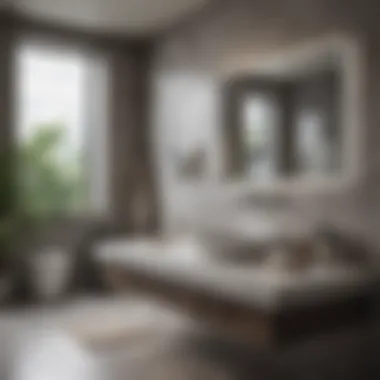
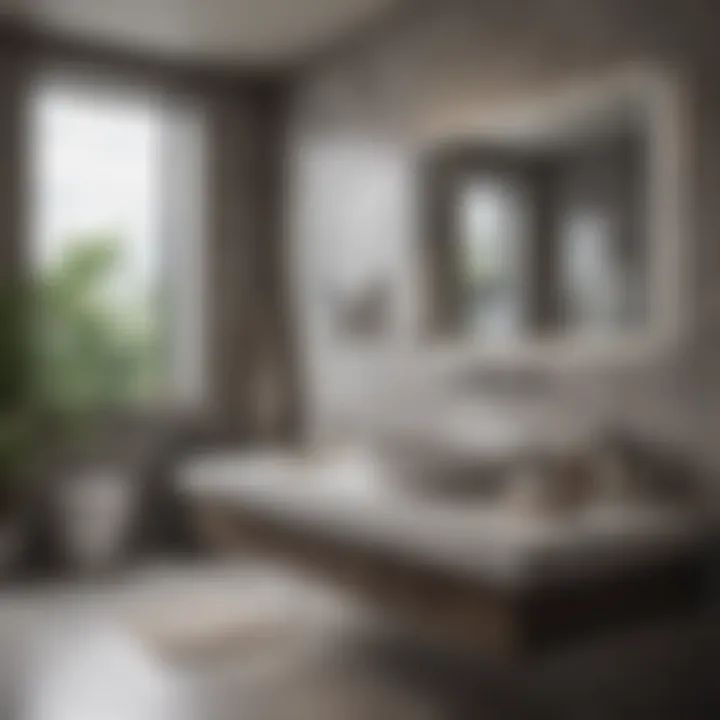
- Width of Entryways: Doors should be wide enough to accommodate mobility devices. A standard door width of at least 36 inches is recommended.
- Grab Bars: Strategically placed bars next to toilets and in showers can assist individuals in maintaining balance. These should be installed securely to support weight.
- Getting in and out of the Shower or Bathtub: A step-in shower can be a great option, as it reduces the barriers faced by those with limited mobility. Non-slip surfaces are also critical to prevent falls.
- Accessible Fixtures: Toilets should be at a height that makes them easy to use for individuals who might have trouble with standard heights.
"Designing bathrooms that respect the needs of all individuals not only transform spaces into pleasant retreats but also champions a more inclusive society."
- Visual Considerations: High-contrast features, like dark grips or light tiles, can assist those with visual impairments.
By incorporating these features, you not only create a bathroom that promotes independence but also one that is welcoming and functional for all.
Universal design principles
Universal design is about blending aesthetics with functionality, ensuring that spaces can be enjoyed by everyone regardless of age or ability. Some fundamental principles of universal design in bathrooms include:
- Equitable Use: Designs should be useful and marketable to people with diverse abilities. This can include flexible counter heights or adjustable showerheads.
- Flexibility in Use: Provide multiple ways to utilize each space, such as a handheld showerhead that can cater to different preferences.
- Simple and Intuitive Use: All users should find the space easy to navigate. Clear signage and well-placed controls can enhance usability.
- Perceptible Information: Important information must be communicated effectively to all users. Clear visual cues, audio signals, and tactile formats should be utilized.
By adhering to universal design principles, bathrooms not only serve their primary function but also become spaces where dignity and comfort are paramount, reinforcing the notion that inclusivity should be a given, not an afterthought.
Trends in Contemporary bathroom Design
Contemporary bathrooms are evolving at a breakneck pace, responding to innovations in technology, shifting aesthetic tastes, and a growing awareness of environmental sustainability. Understanding these trends is imperative not just for architects and designers, but for homeowners who wish to create spaces that resonate with the ethos of our times. Trends in bathroom design are often indicators of broader social changes, making this a fascinating area to explore.
Designing a bathroom today means weaving together style, practicality, and a touch of personal flair. Many people view their bathrooms as a sanctuary, a place where they can escape the hustle and bustle of daily life. Therefore, modern trends often emphasize relaxation and tranquility. Homeowners are not just selecting tiles and fixtures—they’re curating experiences.
Emerging styles in
In 2023, we are seeing a delightful blend of styles that marry the old with the new. Here are some noteworthy trends:
- Biophilic Design: This style incorporates natural elements into the bathroom, bridging the gap between indoor and outdoor spaces. Plants, stone finishing, and natural light create a comforting atmosphere.
- Bold Colors and Patterns: While neutral palettes still hold sway, vibrant hues are carving their space, adding character. Homeowners are often daring with their color choices, focusing on creating a unique visual experience.
- Vintage Touches: Retro fixtures, such as clawfoot tubs and antique vanities, are making a strong comeback. Such pieces infuse warmth and charm into otherwise sleek modern interiors.
All these styles reflect a desire to bring individuality into private spaces. This customization aspect is critical. People are looking for bathrooms that embody their tastes—a reflection of their personalities.
Influence of minimalist design
Minimalism is not just a fad; it's a philosophy that has permeated various aspects of design, including bathrooms. The essence of minimalism is simplicity, and this extends to:
- Clutter Reduction: An emphasis on decluttering is crucial. With fewer accessories and a focus on essential elements, bathrooms become not just more functional but also aesthetic sanctuaries of calm.
- Sleek Lines: Fixtures and fittings are leaning towards clean, geometric shapes—think floating vanities and frameless showers. This clarity is visually appealing and often enhances the perception of space.
- Neutral Color Schemes: The adoption of whites, greys, and other soft tones maintains the soothing atmosphere that’s vital in a bathroom. These shades can create a canvas to which homeowners can add splashes of color through towels or plants.
"Minimalism in bathroom design is about stripping down to the essentials. It can transform the experience of daily routines into a moment of mindfulness."
The influence of minimalism signifies a desire for a more straightforward, intentional living experience. In today’s fast-paced world, the ease and tranquility provided by minimalist designs are becoming increasingly desirable.
With such rich trends shaping the contemporary bathroom landscape, it's essential to consider not only aesthetics but also practical implications. The integration of emerging styles and minimalist elements can transform a mundane bathroom into a stunning personal haven.
Future Directions in Bathroom Design
As we look towards the future of bathroom design, understanding the evolving landscape is crucial. This section emphasizes future directions as an area of immense potential for innovation. Homeowners and designers alike need to keep their fingers on the pulse of what’s next. The importance of embracing these changes can’t be overstated. Not only do they enhance functionality, but they also address the growing demands for sustainability, smart technology integration, and user-centric designs.
Technological advancements on the horizon
Technological advancements are shaking up the very foundations of bathroom design. The introduction of smart devices has transformed how we interact with our spaces. Imagine your bathroom lighting adjusting based on your mood, or water-saving toilets that not only conserve water but can analyze your hydration levels. These aren’t mere fantasies; they’re becoming commonplace.
- Smart mirrors: These are revolutionizing daily routines. They can display the weather, news, or reminders as you wash your face in the morning. Additionally, some come equipped with anti-fogging capabilities.
- Voice-activated features: Devices that respond to voice commands streamline your experience. Want the shower to run at a specific temperature? Just ask.
- Health sensors: New technology includes eco-friendly faucets that monitor water consumption and provide insights directly to your smartphone, encouraging more responsible habits.
“In tomorrow’s bathrooms, technology not only meets our needs but anticipates them.”
Yet, while embracing these advancements, it’s crucial to consider data privacy and reliability. Homeowners must choose devices from reputable brands to ensure their personal information remains secure. As technology continues to evolve, designers who stay informed and adaptable will certainly have the edge.
Shifts in consumer preferences
Shifts in consumer preferences encapsulate a broader cultural movement that values personal well-being and sustainability. Homeowners are no longer just looking for aesthetically pleasing designs; they want spaces that resonate with their values.
- Eco-conscious choices: More consumers are prioritizing sustainable materials and energy-efficient fixtures. Recycled or sustainably sourced stones, woods, and tiles are in high demand. This is partly a response to climate concerns and a personal commitment to sustainability.
- Personalized spaces: Bathrooms are no longer just functional; they’re a retreat from the chaos of daily life. Homeowners are leaning towards designs that reflect their styles and preferences, leading to a rise in custom solutions. Builders offering personalized layouts that cater to individual needs can expect high returns on investment.
- Wellness integration: There's a marked increase in homeowners looking for features that elevate personal health. This could mean incorporating steam showers, soaking tubs, or even aromatherapy features that create a calming atmosphere.
Ultimately, as these consumer dynamics reshape expectations, designers, homeowners, and brands must be attuned to these shifts. Those who do stand to gain significantly in terms of customer loyalty and satisfaction.



